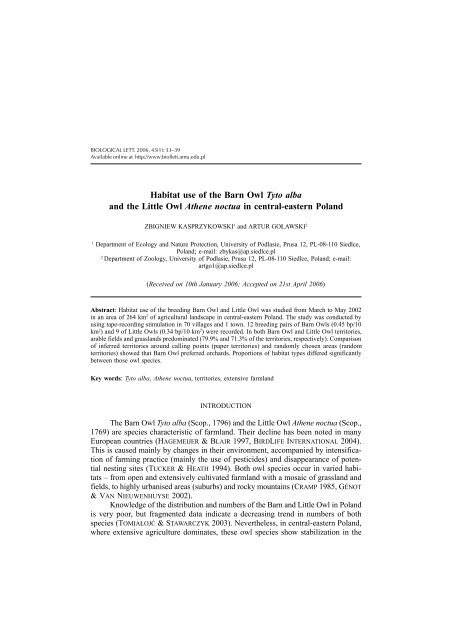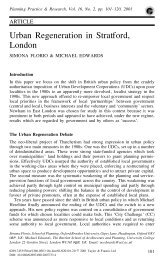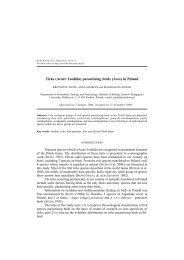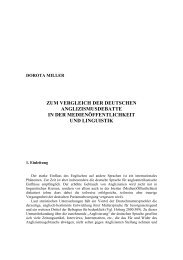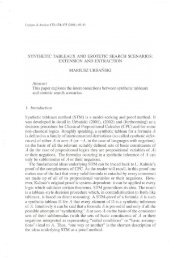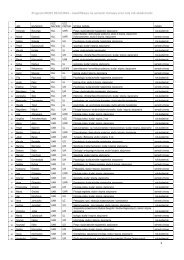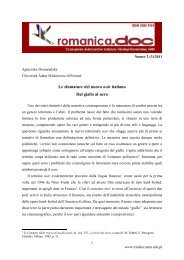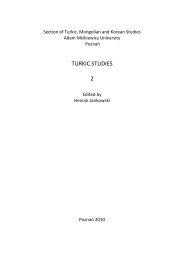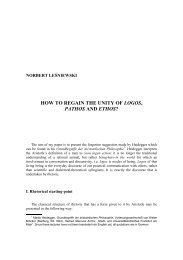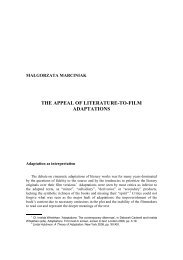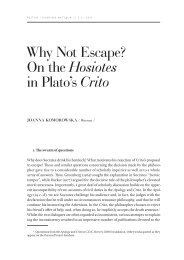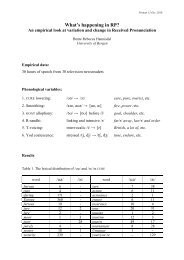Habitat use of the Barn Owl Tyto alba and the Little Owl Athene ...
Habitat use of the Barn Owl Tyto alba and the Little Owl Athene ...
Habitat use of the Barn Owl Tyto alba and the Little Owl Athene ...
You also want an ePaper? Increase the reach of your titles
YUMPU automatically turns print PDFs into web optimized ePapers that Google loves.
HABITAT USE OF THE BARN OWL AND LITTLE OWL33BIOLOGICAL LETT. 2006, 43(1): 33–39Available online at http://www.biollett.amu.edu.pl<strong>Habitat</strong> <strong>use</strong> <strong>of</strong> <strong>the</strong> <strong>Barn</strong> <strong>Owl</strong> <strong>Tyto</strong> <strong>alba</strong><strong>and</strong> <strong>the</strong> <strong>Little</strong> <strong>Owl</strong> A<strong>the</strong>ne noctua in central-eastern Pol<strong>and</strong>ZBIGNIEW KASPRZYKOWSKI 1 <strong>and</strong> ARTUR GO£AWSKI 21Department <strong>of</strong> Ecology <strong>and</strong> Nature Protection, University <strong>of</strong> Podlasie, Prusa 12, PL-08-110 Siedlce,Pol<strong>and</strong>; e-mail: zbykas@ap.siedlce.pl2Department <strong>of</strong> Zoology, University <strong>of</strong> Podlasie, Prusa 12, PL-08-110 Siedlce, Pol<strong>and</strong>; e-mail:artgo1@ap.siedlce.pl(Received on 10th January 2006; Accepted on 21st April 2006)Abstract: <strong>Habitat</strong> <strong>use</strong> <strong>of</strong> <strong>the</strong> breeding <strong>Barn</strong> <strong>Owl</strong> <strong>and</strong> <strong>Little</strong> <strong>Owl</strong> was studied from March to May 2002in an area <strong>of</strong> 264 km 2 <strong>of</strong> agricultural l<strong>and</strong>scape in central-eastern Pol<strong>and</strong>. The study was conducted byusing tape-recording stimulation in 70 villages <strong>and</strong> 1 town. 12 breeding pairs <strong>of</strong> <strong>Barn</strong> <strong>Owl</strong>s (0.45 bp/10km 2 ) <strong>and</strong> 9 <strong>of</strong> <strong>Little</strong> <strong>Owl</strong>s (0.34 bp/10 km 2 ) were recorded. In both <strong>Barn</strong> <strong>Owl</strong> <strong>and</strong> <strong>Little</strong> <strong>Owl</strong> territories,arable fields <strong>and</strong> grassl<strong>and</strong>s predominated (79.9% <strong>and</strong> 71.3% <strong>of</strong> <strong>the</strong> territories, respectively). Comparison<strong>of</strong> inferred territories around calling points (paper territories) <strong>and</strong> r<strong>and</strong>omly chosen areas (r<strong>and</strong>omterritories) showed that <strong>Barn</strong> <strong>Owl</strong> preferred orchards. Proportions <strong>of</strong> habitat types differed significantlybetween those owl species.Key words: <strong>Tyto</strong> <strong>alba</strong>, A<strong>the</strong>ne noctua, territories, extensive farml<strong>and</strong>INTRODUCTIONThe <strong>Barn</strong> <strong>Owl</strong> <strong>Tyto</strong> <strong>alba</strong> (Scop., 1796) <strong>and</strong> <strong>the</strong> <strong>Little</strong> <strong>Owl</strong> A<strong>the</strong>ne noctua (Scop.,1769) are species characteristic <strong>of</strong> farml<strong>and</strong>. Their decline has been noted in manyEuropean countries (HAGEMEIJER & BLAIR 1997, BIRDLIFE INTERNATIONAL 2004).This is ca<strong>use</strong>d mainly by changes in <strong>the</strong>ir environment, accompanied by intensification<strong>of</strong> farming practice (mainly <strong>the</strong> <strong>use</strong> <strong>of</strong> pesticides) <strong>and</strong> disappearance <strong>of</strong> potentialnesting sites (TUCKER & HEATH 1994). Both owl species occur in varied habitats– from open <strong>and</strong> extensively cultivated farml<strong>and</strong> with a mosaic <strong>of</strong> grassl<strong>and</strong> <strong>and</strong>fields, to highly urbanised areas (suburbs) <strong>and</strong> rocky mountains (CRAMP 1985, GÉNOT& VAN NIEUWENHUYSE 2002).Knowledge <strong>of</strong> <strong>the</strong> distribution <strong>and</strong> numbers <strong>of</strong> <strong>the</strong> <strong>Barn</strong> <strong>and</strong> <strong>Little</strong> <strong>Owl</strong> in Pol<strong>and</strong>is very poor, but fragmented data indicate a decreasing trend in numbers <strong>of</strong> bothspecies (TOMIA£OJÆ & STAWARCZYK 2003). Never<strong>the</strong>less, in central-eastern Pol<strong>and</strong>,where extensive agriculture dominates, <strong>the</strong>se owl species show stabilization in <strong>the</strong>
34 Z. Kasprzykowski <strong>and</strong> A. Go³awskilast 20 years (DOMBROWSKI et al. 2004). The aim <strong>of</strong> <strong>the</strong> present paper was to definehabitat preferences <strong>of</strong> <strong>the</strong> <strong>Barn</strong> <strong>Owl</strong> <strong>and</strong> <strong>the</strong> <strong>Little</strong> <strong>Owl</strong> in <strong>the</strong> agricultural l<strong>and</strong>scape<strong>of</strong> central-eastern Pol<strong>and</strong>. Identification <strong>of</strong> habitat preferences <strong>of</strong> both owl speciescan be important for <strong>the</strong>ir active conservation, as <strong>the</strong> structure <strong>of</strong> l<strong>and</strong>scape can affect<strong>the</strong>ir breeding success (BOND et al. 2004).STUDY AREA AND METHODSThe study was conducted in <strong>the</strong> eastern part <strong>of</strong> <strong>the</strong> Mazovia Province (52°17’N;22°17’E at <strong>the</strong> centre <strong>of</strong> <strong>the</strong> plot, 140-160 m above <strong>the</strong> sea level: central-easternPol<strong>and</strong>), which is characterised by a highly fragmented agricultural l<strong>and</strong>scape (Fig.1). The study plot covered 264 km 2 <strong>and</strong> was located 10 km north <strong>of</strong> <strong>the</strong> town <strong>of</strong>Siedlce, where arable fields predominated (Fig. 2). The study area includes 70 villages<strong>and</strong> settlements <strong>and</strong> <strong>the</strong> town <strong>of</strong> Mordy (ca 2500 inhabitants).Between March <strong>and</strong> May 2002, human settlements (including single buildings)were visited twice <strong>and</strong> tape-recording stimulation was <strong>use</strong>d. The first control wasFig. 1. Map <strong>of</strong> <strong>the</strong> study plotperformed between 12th March <strong>and</strong> 19th April, <strong>and</strong> <strong>the</strong> second one between 23rdApril <strong>and</strong> 3rd May. Depending on settlement size, 1-5 points <strong>of</strong> stimulation were setup (140 in total), where calls <strong>of</strong> <strong>the</strong> <strong>Little</strong> <strong>Owl</strong> <strong>and</strong> <strong>of</strong> <strong>the</strong> <strong>Barn</strong> <strong>Owl</strong> were played in3-minute sequences. The control <strong>of</strong> <strong>the</strong> whole study plot lasted 4 nights. In addition,
HABITAT USE OF THE BARN OWL AND LITTLE OWL35Woods16.7%Orchards1.3%Settlements4.4%Grassl<strong>and</strong>s19,0%Arable fields58.6%Fig. 2. <strong>Habitat</strong> structure <strong>of</strong> <strong>the</strong> study plot<strong>the</strong> third control was done (on 6th/7th May) at <strong>the</strong> sites where <strong>the</strong> occurrence <strong>of</strong> one<strong>of</strong> <strong>the</strong> species during <strong>the</strong> first 2 controls was suspected. Additionally, we visitedall 11 churches situated in this area, beca<strong>use</strong> <strong>Barn</strong> <strong>Owl</strong>s <strong>of</strong>ten occupied high churchtowers (GO£AWSKI et al. 2003).<strong>Habitat</strong> preferences <strong>of</strong> both owl species were studied basing on comparison <strong>of</strong>proportions <strong>of</strong> certain habitats within paper territories <strong>and</strong> r<strong>and</strong>om territories. Paperterritories were assigned by drawing circles centred upon <strong>the</strong> sites <strong>of</strong> records <strong>of</strong> singingindividuals. When during 2 inspections <strong>the</strong> birds were heard from different places,as a centre <strong>of</strong> <strong>the</strong> territory a point in half distance between calls was assumed. Therewas a single such case in each species, <strong>and</strong> distances between encounters <strong>of</strong> birdsduring both <strong>the</strong>se controls did not exceed 100 m. From among <strong>the</strong> stimulation pointswhere no owls were encountered, points established as centres <strong>of</strong> r<strong>and</strong>om territorieswere chosen at r<strong>and</strong>om. The number <strong>and</strong> size <strong>of</strong> r<strong>and</strong>om territories was <strong>the</strong> same as<strong>the</strong> number <strong>and</strong> size <strong>of</strong> paper territories <strong>of</strong> each owl species (12 for <strong>the</strong> <strong>Barn</strong> <strong>Owl</strong><strong>and</strong> 9 for <strong>the</strong> <strong>Little</strong> <strong>Owl</strong>). It was also assumed that <strong>the</strong> centre <strong>of</strong> a r<strong>and</strong>om territoryshould be located at least 5 km from <strong>the</strong> compared paper territory. The area <strong>of</strong> eachhabitat within territories <strong>of</strong> both types was calculated with a planimeter from a topographicalmap on a scale <strong>of</strong> 1:10 000.Beca<strong>use</strong> <strong>of</strong> a lack <strong>of</strong> data from Pol<strong>and</strong> about <strong>the</strong> size <strong>of</strong> owl territories, datafrom o<strong>the</strong>r countries <strong>of</strong> Central Europe were <strong>use</strong>d for comparison. Densities <strong>of</strong> bothspecies on <strong>the</strong> study plot were relatively low <strong>and</strong> <strong>the</strong> radius <strong>of</strong> <strong>the</strong>se circles correspondsto <strong>the</strong> maximum territory size <strong>of</strong> each species. The <strong>Barn</strong> <strong>Owl</strong> territories wereestimated at 1500 m (706 ha) – (CRAMP 1985, MICHELAT & GIRAUDOUX 1991), whilethose <strong>of</strong> <strong>Little</strong> <strong>Owl</strong>s were estimated at 440 m (60 ha) – (FINCK 1990, GÉNOT & VANNIEUWENHUYSE 2002). Constant size <strong>of</strong> <strong>the</strong> territories was assumed, although it maychange during <strong>the</strong> breeding season (FINCK 1990, ROULIN 2002).
36 Z. Kasprzykowski <strong>and</strong> A. Go³awskiIn <strong>the</strong> statistic analyses for comparisons <strong>of</strong> <strong>the</strong> habitat size between paper <strong>and</strong>r<strong>and</strong>om territories, Fisher’s linear discriminant (FLD) was <strong>use</strong>d. For comparison <strong>of</strong>proportions <strong>of</strong> habitats in paper territories <strong>of</strong> both species <strong>of</strong> owls, <strong>the</strong> G test was<strong>use</strong>d (SOKAL & ROHLF 2001). All statistics were calculated with <strong>the</strong> program Statistica(STATSOFT 2003).RESULTSWe recorded 12 breeding pairs <strong>of</strong> <strong>the</strong> <strong>Barn</strong> <strong>Owl</strong> (0.45 bp/10 km 2 ) <strong>and</strong> 9 <strong>of</strong> <strong>the</strong><strong>Little</strong> <strong>Owl</strong> (0.34 bp/10 km 2 ). Three broods <strong>of</strong> <strong>the</strong> <strong>Barn</strong> <strong>Owl</strong> were located in churches<strong>and</strong> <strong>the</strong> fourth pair regularly visited a church, although <strong>the</strong>y had a nest in ano<strong>the</strong>rplace. One church visited by a <strong>Little</strong> <strong>Owl</strong> was also identified.Paper territories <strong>of</strong> both owl species included 5 types <strong>of</strong> habitat (Table 1). Thepercentage <strong>of</strong> habitat types differed significantly between <strong>the</strong> 2 owl species (G-test:G 4= 10.4, P = 0.034). In <strong>Barn</strong> <strong>Owl</strong> paper territories, arable fields predominated, asTable 1. Area <strong>of</strong> habitats (ha) in paper (P) <strong>and</strong> r<strong>and</strong>om territories (R) <strong>of</strong> <strong>the</strong> <strong>Barn</strong> <strong>Owl</strong> <strong>Tyto</strong> <strong>alba</strong> <strong>and</strong><strong>Little</strong> <strong>Owl</strong> A<strong>the</strong>ne noctua<strong>Habitat</strong><strong>Barn</strong> <strong>Owl</strong><strong>Little</strong> <strong>Owl</strong>P R P RMean SE Mean SE Mean SE Mean SEArable fields 422.6 22.56 411.9 28.36 32.9 3.61 39.8 4.09Grassl<strong>and</strong>s 141.7 19.08 146.6 17.97 10.0 1.71 11.9 2.59Woods 85.9 22.47 113.6 22.16 3.5 1.30 1.2 0.99Orchards 18.5 6.15 3.2 1.65 3.7 2.42 0.7 0.66Settlements 37.3 8.44 30.7 4.41 9.9 3.17 6.4 1.95<strong>the</strong>y reached 59.8% <strong>of</strong> <strong>the</strong> area. Toge<strong>the</strong>r with grassl<strong>and</strong>s, open areas covered 79.9%<strong>of</strong> <strong>the</strong> territories. Woods covered 12.2%, orchards 2.6%, <strong>and</strong> human settlements 5.3%.Differences in habitat structure between paper <strong>and</strong> r<strong>and</strong>om territories were statisticallysignificant (ANOVA, F 1,22= 5.74, P = 0.026). The model explained 20% <strong>of</strong> <strong>the</strong>Table 2. Results <strong>of</strong> Fisher’s linear discriminant analysis <strong>of</strong> <strong>the</strong> <strong>Barn</strong> <strong>Owl</strong> paper <strong>and</strong> r<strong>and</strong>om territoriesVariable B SE t POrchards0.014 0.006 2.396 0.026Constant0.353 0.113 3.123 0.005F 1,22 = 5.74, P = 0.026, R 2 = 0.20
HABITAT USE OF THE BARN OWL AND LITTLE OWL37variance in size <strong>of</strong> particular habitats in both kinds <strong>of</strong> territories. Only orchards turnedout significant in <strong>the</strong> analysis (P = 0.026, Table 2)In <strong>Little</strong> <strong>Owl</strong> paper territories, arable fields reached 54.6% <strong>of</strong> <strong>the</strong> area. Settlements<strong>and</strong> grassl<strong>and</strong>s covered, respectively, 16.6% <strong>and</strong> 16.7% <strong>of</strong> <strong>the</strong> territories. Lowerproportions were covered by orchards (6.2%) <strong>and</strong> woodl<strong>and</strong>s (5.9%). The area <strong>of</strong>habitat did not differ significantly between paper <strong>and</strong> r<strong>and</strong>om territories (ANOVA,F 5,12= 1.33, P = 0.317).DISCUSSIONThe density <strong>of</strong> <strong>the</strong> <strong>Little</strong> <strong>Owl</strong> in this study was lower than in o<strong>the</strong>r types <strong>of</strong>l<strong>and</strong>scape in Pol<strong>and</strong> (TOMIA£OJÆ & STAWARCZYK 2003). However, most studies inPol<strong>and</strong> were carried out at least a dozen years ago, when numbers <strong>of</strong> <strong>the</strong> <strong>Little</strong> <strong>Owl</strong>were much higher. The noted density <strong>of</strong> <strong>the</strong> <strong>Barn</strong> <strong>Owl</strong> was high in comparison witho<strong>the</strong>r regions <strong>of</strong> Pol<strong>and</strong> (TOMIA£OJÆ & STAWARCZYK 2003). A high number <strong>of</strong> thisspecies could be a result <strong>of</strong> <strong>the</strong> protection project conducted in this area (GO£AWSKI2001). In comparison with western <strong>and</strong> sou<strong>the</strong>rn Europe (HAGEMEIJER & BLAIR 1997),breeding densities <strong>of</strong> both owl species in <strong>the</strong> study area were lower, probably beca<strong>use</strong>in eastern Pol<strong>and</strong> <strong>the</strong>y reach <strong>the</strong> north-western edges <strong>of</strong> <strong>the</strong>ir breeding ranges.Both species <strong>of</strong> owls are in Europe closely associated with open habitats <strong>of</strong>agricultural l<strong>and</strong>scape (CRAMP 1985). In central-eastern Pol<strong>and</strong>, arable fields <strong>and</strong>grassl<strong>and</strong>s – <strong>the</strong>ir main feeding habitats – also predominated within paper territories<strong>of</strong> both <strong>the</strong> <strong>Barn</strong> <strong>Owl</strong> <strong>and</strong> <strong>the</strong> <strong>Little</strong> <strong>Owl</strong>. However, <strong>the</strong> coverage <strong>of</strong> <strong>the</strong>se habitats inr<strong>and</strong>om territories was not significantly different from that in paper territories. Thiswas due to <strong>the</strong> predomination <strong>of</strong> this type <strong>of</strong> habitats in <strong>the</strong> whole study area. Thepresence <strong>of</strong> various open areas is an important factor that influences <strong>the</strong> occurrence<strong>of</strong> both species <strong>of</strong> owls. In France, <strong>Barn</strong> <strong>Owl</strong>s were hunting more <strong>of</strong>ten in areascovered with bushes than on arable fields. Attractiveness <strong>of</strong> this type <strong>of</strong> habitat isconnected with greater body weight <strong>of</strong> prey found <strong>the</strong>re (MICHELAT & GIRAUDOUX1993). A large proportion <strong>of</strong> open areas results in an increase in <strong>Barn</strong> <strong>Owl</strong> prey diversity(VARUZZA et al. 2001). This is confirmed by observations <strong>of</strong> <strong>Barn</strong> <strong>Owl</strong>shunting on pastures <strong>and</strong> tilled fields, <strong>and</strong> – in particular – on stubble fields shortlyafter harvesting (TOMÉ & VALKAMA 2001). In <strong>the</strong> <strong>Little</strong> <strong>Owl</strong>, <strong>the</strong> density was distinctlyrelated to <strong>the</strong> proportion <strong>of</strong> meadows, but it was negatively correlated with<strong>the</strong> area <strong>of</strong> arable l<strong>and</strong> (GÉNOT & VAN NIEUWENHUYSE 2002). In <strong>the</strong> Czech Republic,this species also preferred meadows <strong>and</strong> avoided arable fields (ŠÁLEK & BEREC2001). The increase in <strong>the</strong> proportion <strong>of</strong> fields with a concurrent decrease in grassl<strong>and</strong>areas, ca<strong>use</strong>d a decrease in density <strong>of</strong> <strong>the</strong> <strong>Barn</strong> <strong>Owl</strong> in <strong>the</strong> agricultural l<strong>and</strong>scape<strong>of</strong> North America (COLVIN 1985) <strong>and</strong> <strong>of</strong> <strong>the</strong> <strong>Little</strong> <strong>Owl</strong> in Austria (ILLE &GRINSCHGL 2001).As a result <strong>of</strong> <strong>the</strong> high l<strong>and</strong>scape fragmentation in <strong>the</strong> study area, <strong>the</strong> paperterritories <strong>of</strong> both species included woodl<strong>and</strong>s. The negative influence <strong>of</strong> woodl<strong>and</strong>son <strong>Barn</strong> <strong>Owl</strong> density was stated, e.g., in Fl<strong>and</strong>ers, Spain, Czech Republic <strong>and</strong> Italy(CENTILI 2001, ŠÁLEK & BEREC 2001, VAN NIEUWENHUYSE & BEKAERT 2001,ZUBEROGOITIA & MARTINEZ-CLIMENT 2001). In <strong>the</strong> <strong>Barn</strong> <strong>Owl</strong> in central-easternPol<strong>and</strong>, a distinct preference for orchards was found. This preference did not seem
38 Z. Kasprzykowski <strong>and</strong> A. Go³awskito be ca<strong>use</strong>d by <strong>the</strong> spatial correlation between orchards <strong>and</strong> settlements (paper territories:R = -0.13, P = 0.693, N = 12; r<strong>and</strong>om territories: R = -0.10, P = 0.750, N= 12). We did not find any preferences for orchards in <strong>the</strong> <strong>Little</strong> <strong>Owl</strong>, although thisrelationship was described by many researchers. In many places <strong>of</strong> <strong>Little</strong> <strong>Owl</strong> occurrencein Europe, orchards covered even as much as 20% <strong>of</strong> <strong>the</strong> area (GÉNOT & VANNIEUWENHUYSE 2002). Orchards provide favourable conditions beca<strong>use</strong> <strong>of</strong> preyabundance (insects) on regularly mowed meadows (ILLE & GRINSCHGL 2001). Moreover,old fruit trees are suitable nesting places. A strong preference for sunflowerfields <strong>and</strong> olive tree areas <strong>and</strong> avoidance <strong>of</strong> grassl<strong>and</strong> <strong>and</strong> marshl<strong>and</strong> were observedin <strong>the</strong> <strong>Little</strong> <strong>Owl</strong> in Spain by FAJARDO et al. (1998). Those authors explain <strong>the</strong>sepreferences mainly by a high attractiveness <strong>of</strong> olive tree areas in comparison withgrassl<strong>and</strong>s.The presence <strong>of</strong> built-up areas in owl territories is connected with <strong>the</strong> availability<strong>of</strong> breeding sites. Both described species <strong>of</strong> owls <strong>of</strong>ten <strong>use</strong> buildings as nestingplaces (CRAMP 1985). <strong>Barn</strong> <strong>Owl</strong>s favour, in particular, farm buildings <strong>and</strong> churches(KOPIJ 1990, BRUIJN 1994, BAUDVIN & JOUAIRE 2001), although in Engl<strong>and</strong> ahigh proportion <strong>of</strong> nests was observed in hollow trees (BUNN et al. 1992). However,<strong>Little</strong> <strong>Owl</strong>s <strong>use</strong> buildings <strong>and</strong> most <strong>of</strong>ten nest in hollows under <strong>the</strong> ro<strong>of</strong> (GÉNOT &VAN NIEUWENHUYSE 2002). Although <strong>the</strong> species breeds equally <strong>of</strong>ten in tree cavities,a distinct relation to sparsely built-up areas was found (VAN NIEUWENHUYSE& NOLLET 1991, MARTÍNEZ & ZUBEROGOITIA 2004). The higher proportion <strong>of</strong> humansettlements in <strong>the</strong> <strong>Little</strong> <strong>Owl</strong> territories in comparison with <strong>the</strong> <strong>Barn</strong> <strong>Owl</strong> foundin our study probably results from smaller territories <strong>of</strong> <strong>the</strong> first species.Acknowledgements: We wish to thank C. MITRUS for critical comments on <strong>the</strong> first draft.REFERENCESBAUDVIN H., JOUAIRE S. 2001. Breeding biology <strong>of</strong> <strong>the</strong> <strong>Barn</strong> <strong>Owl</strong> (<strong>Tyto</strong> <strong>alba</strong>) in Burgundy (France):a 25-year study (1971–1995). Buteo 12: 5–12.BIRDLIFE INTERNATIONAL 2004. Birds in Europe: population estimates, trends <strong>and</strong> conservationstatus. BirdLife International (BirdLife Conservation Series No. 12), Cambridge, UK.BOND G., BURNSIDE N. G., METCALFE D. J., SCOTT D. M., BLAMIRE J. 2004. The effects <strong>of</strong> l<strong>and</strong><strong>use</strong><strong>and</strong> l<strong>and</strong>scape structure on barn owl (<strong>Tyto</strong> <strong>alba</strong>) breeding success in sou<strong>the</strong>rn Engl<strong>and</strong>,U.K. L<strong>and</strong>scape Ecol. 20: 555–566.BRUIJN O. 1994. Population ecology <strong>and</strong> conservation <strong>of</strong> <strong>the</strong> barn owl <strong>Tyto</strong> <strong>alba</strong> in farml<strong>and</strong> habitatsin Liemers <strong>and</strong> Achterhoek (The Ne<strong>the</strong>rl<strong>and</strong>s). Ardea 82: 1–109.BUNN D. S., WARBURTON A. B., WILSON R. D. S. 1992. The <strong>Barn</strong> <strong>Owl</strong>. T & A D Poyser, London.CENTILI D. 2001. A <strong>Little</strong> <strong>Owl</strong> population <strong>and</strong> its relationships with humans in central Italy. Ciconia25: 153–158.COLVIN B. A. 1985. Common <strong>Barn</strong>-<strong>Owl</strong> population decline in Ohio <strong>and</strong> <strong>the</strong> relationship to agriculturaltrends. J. Field Ornithol. 56: 224–235.CRAMP S. (Ed.) 1985. The Birds <strong>of</strong> <strong>the</strong> Western Palearctic. Vol. IV. Oxford University Press, Oxford,New York.DOMBROWSKI A., KOT H., GO£AWSKI A., KASPRZYKOWSKI Z. 2004. Zmiany liczebnoœci sów Strigiformesw krajobrazie rolniczym Wysoczyzny Siedleckiej w latach 1984 i 2002 [Fluctuations
HABITAT USE OF THE BARN OWL AND LITTLE OWL39in <strong>the</strong> numbers <strong>of</strong> owls Strigiformes breeding in <strong>the</strong> agricultural l<strong>and</strong>scape <strong>of</strong> <strong>the</strong> WysoczyznaSiedlecka region in 1984–1985 <strong>and</strong> 2002]. Not. Orn. 45: 41–44.FAJARDO I., PIVIDAL V., TRIGO M., JIMËNEZ M. 1998. <strong>Habitat</strong> selection, activity peaks <strong>and</strong> strategiesto avoid road mortality by <strong>the</strong> <strong>Little</strong> <strong>Owl</strong> A<strong>the</strong>ne noctua. Alauda 66: 49–60.FINCK P. 1990. Seasonal variation <strong>of</strong> territory size with <strong>the</strong> <strong>Little</strong> <strong>Owl</strong> (A<strong>the</strong>ne noctua). Oecologia83: 68–75.GÉNOT J. C., VAN NIEUWENHUYSE D. 2002. A<strong>the</strong>ne noctua <strong>Little</strong> <strong>Owl</strong>. BWP Update 4 (1): 35–63.GO£AWSKI A. 2001. Program ochrony p³omykówki <strong>Tyto</strong> <strong>alba</strong> (Scop.) na Mazowszu [Programmefor <strong>the</strong> protection <strong>of</strong> <strong>the</strong> <strong>Barn</strong> <strong>Owl</strong> <strong>Tyto</strong> <strong>alba</strong> (Scop.) in <strong>the</strong> Mazovian Lowl<strong>and</strong>]. In: Strategyfor conservation <strong>of</strong> fauna in <strong>the</strong> Mazovian Lowl<strong>and</strong> (KOT H., DOMBROWSKI A., Eds), pp. 371–376, MTOF, Siedlce.GO£AWSKI A., KASPRZYKOWSKI Z., KOWALSKI M. 2003. The occurrence <strong>of</strong> <strong>the</strong> <strong>Barn</strong> <strong>Owl</strong> <strong>Tyto</strong> <strong>alba</strong>in sacred buildings in central-eastern Pol<strong>and</strong>. Ornis Hungarica 12–13: 275–278.HAGEMEIJER W. J. M., BLAIR M. J. 1997. The EBCC Atlas <strong>of</strong> European Breeding Birds. TheirDistribution <strong>and</strong> Abundance. T & A D Poyser, London.ILLE R., GRINSCHGL F. 2001. <strong>Little</strong> <strong>Owl</strong> (A<strong>the</strong>ne noctua) in Austria. <strong>Habitat</strong> characteristics <strong>and</strong>population density. Ciconia 25: 129–140.KOPIJ G. 1990. Rozmieszczenie i liczebnoœæ p³omykówki (<strong>Tyto</strong> <strong>alba</strong>) na po³udniowej OpolszczyŸnie[Distribution <strong>and</strong> numbers <strong>of</strong> <strong>the</strong> <strong>Barn</strong> <strong>Owl</strong> in <strong>the</strong> sou<strong>the</strong>rn part <strong>of</strong> <strong>the</strong> province <strong>of</strong> Opole].Not. Orn. 31: 43–52.MARTÍNEZ J. A., ZUBEROGOITIA I. 2004. <strong>Habitat</strong> preferences for Long-eared <strong>Owl</strong>s Asio otus <strong>and</strong><strong>Little</strong> <strong>Owl</strong>s A<strong>the</strong>ne noctua in semi-arid environments at three spatial scales. Bird Study 51:163–169.MICHELAT D., GIRAUDOUX P. 1991. Dimension du domaine vital de la Chouette effraie <strong>Tyto</strong> <strong>alba</strong>pendant la nidification. Alauda 59: 137–142.MICHELAT D., GIRAUDOUX P. 1993. Relation proies-prédateur-paysage chez la Chouette effraie <strong>Tyto</strong><strong>alba</strong> pendant l’élevage des jeunes. Alauda 61: 65–72.ROULIN A. 2002. <strong>Tyto</strong> <strong>alba</strong> <strong>Barn</strong> <strong>Owl</strong>. BWP Update 4 (2): 115–138.ŠÁLEK M., BEREC M. 2001. Rozšíøení a biotopové preference sýèka obecného (A<strong>the</strong>ne noctua)ve vybraných oblastech jižních Èech [Distribution <strong>and</strong> biotope preferences <strong>of</strong> <strong>the</strong> <strong>Little</strong><strong>Owl</strong> (A<strong>the</strong>ne noctua) in selected areas <strong>of</strong> <strong>the</strong> Sou<strong>the</strong>rn Bohemia (Czech Republic)]. Buteo12: 127–134.SOKAL R. R., ROHLF F. J. 2001. Biometry. Freman <strong>and</strong> Co., New York.STATSOFT, INC. 2003. Statistica (data analysis s<strong>of</strong>tware system), version 6. www.stats<strong>of</strong>t.co.TUCKER G. M., HEATH M. F. 1994. Birds in Europe: <strong>the</strong>ir conservation status. BirdLife International,Cambridge, UK.TOMÉ R., VALKAMA J. 2001. Seasonal variation in <strong>the</strong> abundance <strong>and</strong> habitat <strong>use</strong> <strong>of</strong> <strong>Barn</strong> <strong>Owl</strong>s<strong>Tyto</strong> <strong>alba</strong> on lowl<strong>and</strong> farml<strong>and</strong>. Ornis Fennica 78: 109–118.TOMIA£OJÆ L., STAWARCZYK T. 2003. Awifauna Polski. Rozmieszczenie, liczebnoœæ i zmiany [TheAvifauna <strong>of</strong> Pol<strong>and</strong>. Distribution, numbers <strong>and</strong> trend]. PTPP “Pro Natura”, Wroc³aw.VAN NIEUWENHUYSE D., BEKAERT M. 2001. Modèle de régression logistique de prédiction de laqualité d’habitat de la Chevêche D’athéna (A<strong>the</strong>ne noctua) à Herzele, Fl<strong>and</strong>re Orientale (nordestde la Belgique) [A Logistic Regression Model for prediction <strong>of</strong> <strong>the</strong> suitability <strong>of</strong> l<strong>and</strong>scapesfor <strong>the</strong> <strong>Little</strong> <strong>Owl</strong> (A<strong>the</strong>ne noctua) in Herzele, East-Fl<strong>and</strong>ers (no<strong>the</strong>rn Belgium)]. Ciconia25: 95–102.VAN NIEUWENHUYSE D., NOLLET F. 1991. Biotoopstudie van de Steenuil A<strong>the</strong>ne noctua met behulpvan het clusteringsprogramma Twinspan. Oriolus 57: 57–61.VARUZZA P., CAPIZZI D., SANTINI L., APOLLONIO M. 2001. <strong>Barn</strong> <strong>Owl</strong> <strong>Tyto</strong> <strong>alba</strong> predation on smallmammals in relation to <strong>the</strong> Mediterranean environment (Pisa Province, Italy). Acta Ornithol.36: 153–160.ZUBEROGOITIA I., MARTINEZ-CLIMENT J. A. 2001. The <strong>Little</strong> <strong>Owl</strong> in <strong>the</strong> “Proyecto Noctua”. Ciconia25: 103–108.


